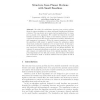99 search results - page 2 / 20 » From structured english to robot motion |
AR
2007
13 years 5 months ago
2007
Abstract— Robot imitation is a useful and promising alternative to robot programming. Robot imitation involves two crucial issues. The first is how a robot can imitate a human w...
ECCV
2002
Springer
14 years 6 months ago
2002
Springer
We study the multi-frame structure from motion problem when the camera translates on a plane with small baselines and arbitrary rotations. This case shows up in many practical appl...
IROS
2006
IEEE
13 years 11 months ago
2006
IEEE
— In this paper we present an analysis of 3D line projections for central catadioptric cameras from a projective perspective. Most algorithms consider the projection of lines as ...
ICRA
2009
IEEE
13 years 11 months ago
2009
IEEE
— Computer vision researchers have proved the feasibility of camera self-calibration —the estimation of a camera’s internal parameters from an image sequence without any know...
IROS
2007
IEEE
13 years 11 months ago
2007
IEEE
— Two novel methods for computing 3D structure information from video for a piecewise planar scene are presented. The first method is based on a new line constraint, which clear...

